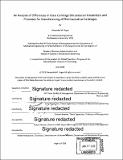| dc.contributor.advisor | Thomas Roemer and Jung-Hoon Chun. | en_US |
| dc.contributor.author | Unger, Alexandra M | en_US |
| dc.contributor.other | Leaders for Global Operations Program. | en_US |
| dc.date.accessioned | 2018-09-17T15:51:40Z | |
| dc.date.available | 2018-09-17T15:51:40Z | |
| dc.date.copyright | 2018 | en_US |
| dc.date.issued | 2018 | en_US |
| dc.identifier.uri | http://hdl.handle.net/1721.1/117961 | |
| dc.description | Thesis: M.B.A., Massachusetts Institute of Technology, Sloan School of Management, in conjunction with the Leaders for Global Operations Program at MIT, 2018. | en_US |
| dc.description | Thesis: S.M., Massachusetts Institute of Technology, Department of Mechanical Engineering, in conjunction with the Leaders for Global Operations Program at MIT, 2018. | en_US |
| dc.description | Some pages printed landscape. Cataloged from PDF version of thesis. | en_US |
| dc.description | Includes bibliographical references (pages 82-84). | en_US |
| dc.description.abstract | The application of silicone inside of glass insulin cartridges helps reduce injection forces during drug delivery. This is important for a less painful patient experience. Insulin pen designs are increasingly reliant on consistent and repeatable injection forces as mechanized injection replaces manual injection. A minimum silicone layer thickness of 40nm is required to produce low gliding forces of approximately two Newtons with little variability. Differences seen in final gliding forces across production areas at Sanofi Insulin Frankfurt are small, but this variation makes it difficult to design for set-force mechanical injection. While the minimum silicone layer thickness required is established, how to achieve it consistently is less understood. This project looked at three insulin packaging lines at Sanofi Insulin Frankfurt that use different methods for siliconization. Differences between these lines were investigated in order to understand which parameters are the most important for creating an acceptable silicone layer thickness. First, each production line was mapped from loading of empty cartridges through the end of the heating tunnel, before insulin is packaged. Differences in the process were found in cleaning procedures, silicone application methods, and production settings. Points for potential variability were found at silicone mixing steps and during start/stop conditions. Lab experiments were developed to test cleaning procedures, heating time, standing time, air pressure of silicone blowout, and silicone concentration. Results from these experiments showed that some production processes have a greater effect than others on silicone layer thickness and subsequent gliding forces. Differences in cleaning procedures on each of the lines have little effect on overall silicone layer thickness and gliding forces. Time in the heating tunnel and standing time have a moderate effect. The largest effects were seen from silicone emulsion concentration and air blow out pressures in the flushing method of silicone application. The following recommendations are given to improve performance consistency across production areas: (I) standardize processes across production areas where possible, (2) reduce air pressure in the flushing process, and (3) eliminate process steps that can lead to several of these effects occurring in the same cartridge. | en_US |
| dc.description.statementofresponsibility | by Alexandra M. Unger. | en_US |
| dc.format.extent | 138 pages | en_US |
| dc.language.iso | eng | en_US |
| dc.publisher | Massachusetts Institute of Technology | en_US |
| dc.rights | MIT theses are protected by copyright. They may be viewed, downloaded, or printed from this source but further reproduction or distribution in any format is prohibited without written permission. | en_US |
| dc.rights.uri | http://dspace.mit.edu/handle/1721.1/7582 | en_US |
| dc.subject | Sloan School of Management. | en_US |
| dc.subject | Mechanical Engineering. | en_US |
| dc.subject | Leaders for Global Operations Program. | en_US |
| dc.title | An analysis of differences in glass cartridge siliconization parameters and processes for manufacturing of pharmaceutical cartridges | en_US |
| dc.type | Thesis | en_US |
| dc.description.degree | M.B.A. | en_US |
| dc.description.degree | S.M. | en_US |
| dc.contributor.department | Leaders for Global Operations Program at MIT | en_US |
| dc.contributor.department | Massachusetts Institute of Technology. Department of Mechanical Engineering | |
| dc.contributor.department | Sloan School of Management | |
| dc.identifier.oclc | 1051237603 | en_US |
